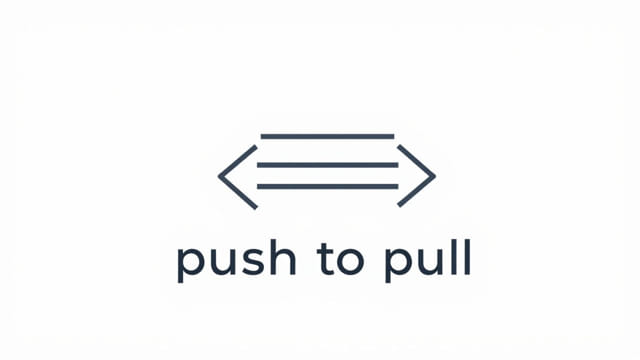In today’s fast-paced world of business, marketing, and supply chain dynamics, one of the most significant shifts has been the movement from push to pull strategies. This transformation reflects a deeper change in how organizations communicate with customers, manage inventory, and respond to demand. Instead of producing goods or pushing information based on predictions, more and more industries are now pulling data, insights, and resources based on actual demand. Understanding this shift is crucial for businesses seeking agility, customer satisfaction, and long-term success.
Understanding Push vs. Pull Concepts
Push Systems
Push strategies are based on forecasts. In manufacturing, this means producing goods in advance and pushing them into the market based on expected demand. In marketing, it refers to delivering messages and advertisements to a wide audience regardless of their current interest level. While push methods offer planning and control benefits, they often lead to overproduction, excess inventory, and misaligned communication.
Pull Systems
On the other hand, pull strategies rely on actual customer demand. Products are made or services are delivered only when needed. In marketing, content is created to attract users who are actively seeking information. In logistics, resources are mobilized in real-time based on consumption data. This approach minimizes waste, improves responsiveness, and enhances the customer experience.
The Shift in Supply Chain Management
From Forecast-Driven to Demand-Driven
One of the most visible transformations from push to pull can be seen in supply chain management. Traditionally, companies manufactured and distributed products based on forecasts. However, inaccuracies in forecasting often caused inefficiencies. Now, with real-time data and better analytics, businesses are shifting to demand-driven models.
- Just-In-Time (JIT) inventory systems reduce holding costs.
- Advanced tracking tools provide visibility into consumption patterns.
- Flexible manufacturing allows for rapid adjustments in production volume.
These methods allow companies to be more adaptive and responsive, reducing losses from unsold products and improving customer service levels.
Technology as a Key Enabler
The adoption of pull systems wouldn’t be possible without advances in technology. Enterprise Resource Planning (ERP) software, predictive analytics, cloud platforms, and Internet of Things (IoT) devices all contribute to a smarter and leaner supply chain. Companies now use data-driven insights to restock only what is necessary, manage resources in real-time, and personalize delivery schedules based on customer preferences.
The Evolution in Marketing Strategies
Traditional Push Marketing
Push marketing involves placing products or messages directly in front of customers, whether they are interested or not. Examples include:
- TV and radio commercials
- Billboard advertisements
- Email blasts to purchased lists
While these methods still have their place, especially in raising brand awareness, they can often feel intrusive or irrelevant to the consumer.
Inbound and Pull Marketing
In contrast, pull marketing or inbound marketing aims to attract customers organically. This is done by offering valuable content that people are already searching for. Pull strategies include:
- Search engine optimization (SEO)
- Content marketing (blogs, videos, guides)
- Social media engagement
- Word-of-mouth and online reviews
This method is more aligned with consumer behavior in the digital age. Instead of being sold to, consumers prefer to research and make informed decisions. Pull marketing supports this behavior by providing helpful, relevant content that draws users in naturally.
Benefits of the Pull Approach
Customer-Centric Strategy
Pull methods are inherently more focused on customer needs. Whether it’s delivering products only when ordered or providing educational content, the goal is to solve real problems rather than make assumptions about what the customer might want. This increases trust and loyalty.
Reduced Waste and Better Resource Use
From production to marketing, pull systems promote efficiency. Businesses only produce what is needed and focus resources on high-potential areas. This lean approach reduces overhead and maximizes return on investment.
Greater Flexibility and Responsiveness
In a pull system, businesses are better equipped to respond to market changes. Sudden shifts in demand, customer feedback, or market conditions can be managed with greater agility. This makes organizations more competitive and resilient in volatile environments.
Challenges of Moving from Push to Pull
Initial Setup and Investment
Transitioning to a pull strategy often requires new technology, training, and a shift in organizational culture. These changes can be costly and time-consuming, especially for companies accustomed to traditional models.
Data Dependency
Pull systems rely heavily on accurate, real-time data. If the data is incomplete or delayed, decision-making suffers. Companies need robust analytics systems and data governance practices to make pull strategies work effectively.
Supply Chain Coordination
Operating a demand-driven supply chain requires close coordination with suppliers, distributors, and retailers. Any breakdown in communication can cause delays or stockouts. Strong partnerships and clear communication channels are essential for success.
Real-World Applications
Retail and E-commerce
Online retailers like Amazon have perfected the pull model by using customer browsing and purchase data to manage inventory and suggest personalized recommendations. This not only improves user experience but also reduces storage and transportation costs.
Automotive Manufacturing
Car manufacturers have implemented pull systems by producing vehicles based on customer orders rather than forecasts. This allows for customization and reduces the risk of unsold stock sitting in lots.
Healthcare and Pharmaceuticals
Hospitals and clinics are adopting pull-based inventory systems to ensure that medical supplies and medications are restocked based on actual usage rather than outdated predictions. This leads to better patient care and less waste.
The shift from push to pull is not merely a trend it’s a fundamental rethinking of how businesses operate in response to evolving consumer expectations and technological capabilities. While the transition comes with its own set of challenges, the benefits of efficiency, customer satisfaction, and agility make the pull approach a smart long-term strategy. Whether in supply chain, marketing, or service delivery, businesses that embrace this shift are positioning themselves for a more responsive and resilient future.
